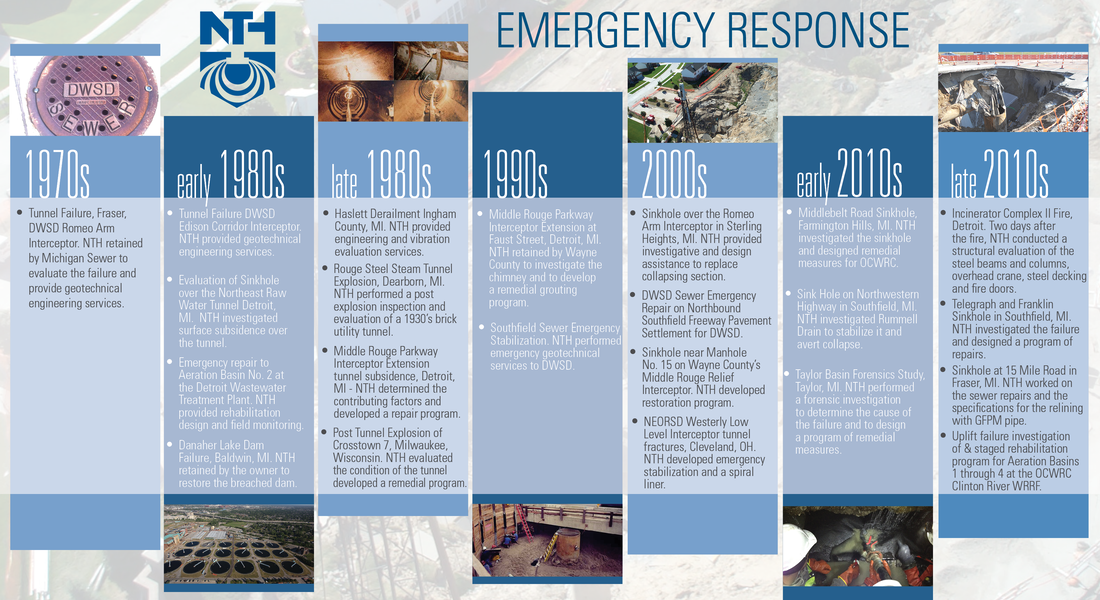Our disasters are more commonly man-made, and often are either caused by or have a tremendous effect on our aging infrastructure. It’s been 15 years since a tree branch in Ohio knocked out power to more than 50 million people in Michigan and throughout the Midwest, Northeast, and Canada. Catastrophic sewer collapses have impacted hundreds of thousands of people in suburban Detroit. While efforts are underway to fund improvements to our water, wastewater, transportation, and energy infrastructure, disaster can still strike at any moment – affecting the lives of millions of people.
Since 1978, NTH has answered the call on more than a dozen emergency response situations related to failed underground infrastructure. We’ve responded to catastrophic sewer collapses throughout Southeast Michigan and Ohio, a collapsed drinking water reservoir in St. Clair County, a collapsed CSO basin in Wayne County, and even failed shoreline protection seawalls at power plants and major shipping terminals. This experience has made us experts in handling infrastructure emergencies by stabilizing disaster areas, providing temporary service (water, sewer, etc.), evaluating the cause, designing the repair, and restoring service with the least possible impact to public health and welfare.
While emergencies and disasters cannot be entirely avoided, proper planning and emergency preparedness can make the recovery process faster, cheaper, and more transparent.
Emergency Action Plans (EAP) are critical for any organization, but for purposes of this article, we’ll consider them from a water/wastewater utility owner’s perspective. When a major piece of infrastructure fails, the first questions are:
- Who do I notify?
- Who do I call for help?
- How did this happen?
- How do I fix it?
A good EAP is designed to provide a utility employee with enough system background, communication information, and response details so that a failure event can be responded to in a timely and organized fashion. The document should be laid out so an employee can turn straight to the appropriate section and begin working on the problem at hand.
The Emergency Action Plan should include details on the normal operating conditions, system construction, likely failure scenarios, methods for stabilization and temporary service, and basic repair details for use during an emergency situation. Another vital part of the plan is internal and external contact information for appropriate notification in the event of a disaster.
Key information includes:
- An overview that contains information intended for all readers, describing the facilities’ operation, location, and construction.
- More detailed information regarding the construction, design, key connections, underlying crossings, history of repairs, and a current condition assessment summary.
- An analysis of system flow, detailing maximum flow rates and flow depths.
- An analysis of likely failure scenarios and modes of failure that the utility could experience.
- Notification plans, phone trees, stake-holder contact information, service providers for emergency response, and typical response requirements (traffic control, security, permits, health and safety requirements, etc.).
- An analysis of flow diversion options, existing bypass options, and conceptual bypass pumping system requirements.
- Detailed information on the consequences of a failure scenario and detailed information on the appropriate repair methods and typical repair drawings.
- A spare parts list for recommended critical items to keep in storage for use in the event of a failure.
Whether you prepare this plan in-house or engage a consultant to assist, the process of developing the plan and the understanding that comes with it can often be much more valuable than the plan document itself. Developing a written plan will force you to collect and inventory all of your vital information and identify information gaps that can be addressed well before disaster strikes. It may even bring to light simple, cost-effective modifications to your utility system to implement now that will make responding to an emergency much simpler, or the impacts of an emergency less severe.
Our experience has also shown us that these emergency situations can have other types of impacts, such as scrutiny over the decisions made and money spent, questioning of procurement processes and no-bid contracts, allegations of impropriety, and even costly litigation. To avoid these pitfalls, utility owners should consider procuring a series of emergency response contracts ahead of time. This will ensure that procurement and contracting practices are consistent with an organization’s culture, policies, and requisite transparency – things that are too often disregarded in the midst of a disaster.
So who do I call?
Most often, NTH gets the call when an emergency strikes because, frankly, we were there when the last one struck! This works, as long as there is someone within the utility owner’s organization that remembers the last time. A more effective approach would be to know exactly who to call ahead of time – either listed in your EAP or by procuring as-needed contracts with consultants, contractors, and suppliers, selected on a qualifications basis, on a three to five-year basis. Consultants under these contracts would be expected to have information assets, regulatory requirements, maintenance of service plans, and other supporting services immediately at hand when an emergency situation arises. Contractors would agree to maintain certain equipment at the ready, and have agreements with suppliers to keep critical components “on the shelf” and readily available.
Having a solid Emergency Action Plan in place and qualified, experienced service providers under contract before disaster strikes will ensure that your system is back up and running as quickly, cost-effectively, and with as little negative impact as possible.


 RSS Feed
RSS Feed